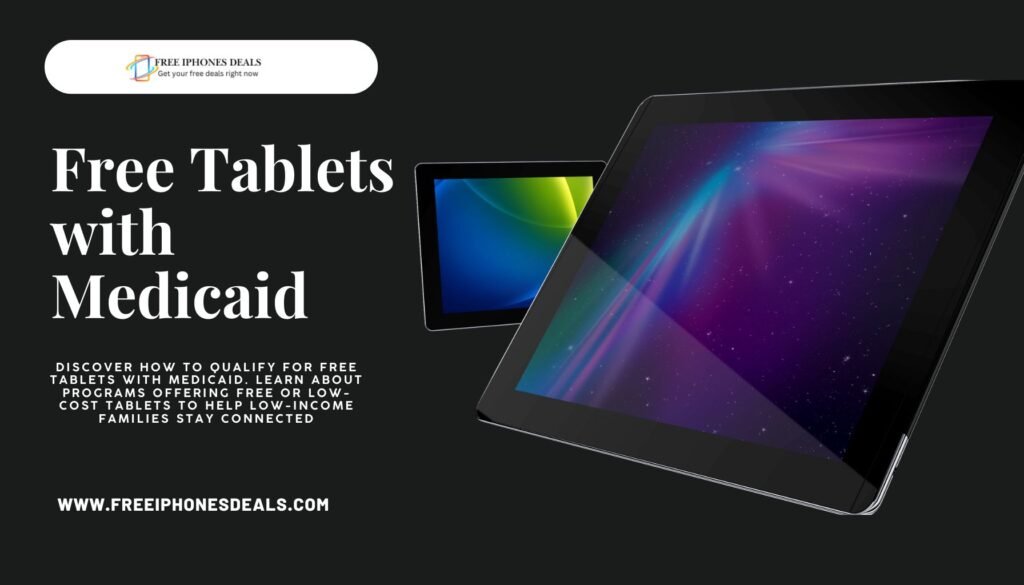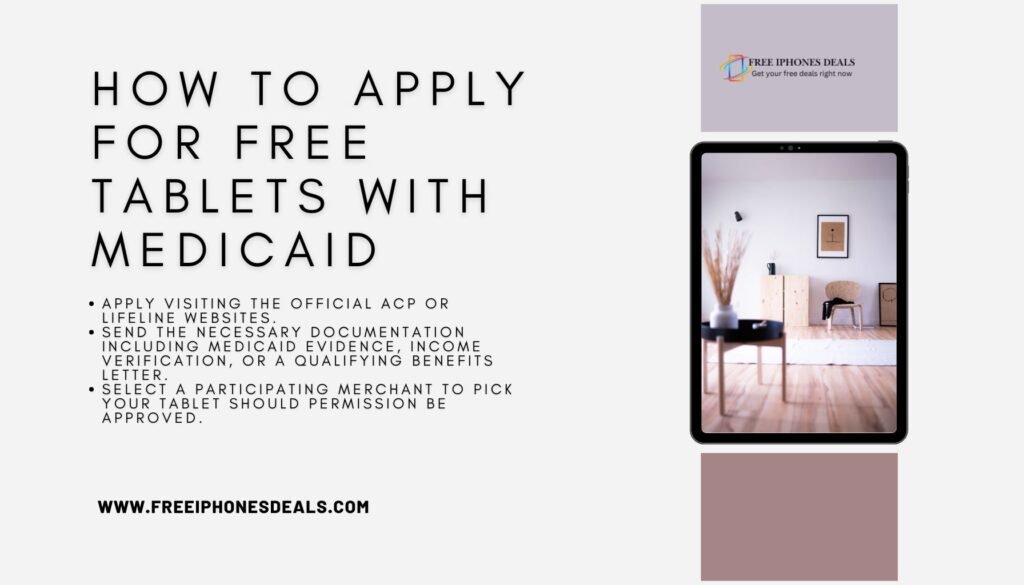Many facets of daily life, including education, healthcare, and work, depend on digital access. free medicaid tablets, Free tablets can offer low-income people—especially those enrolled in Medicaid—needed assistance. To assist close the digital divide, some projects and organizations provide Medicaid users free or heavily reduced tablets. Telehealth visits, government service access, online learning, job searching, and family and friend correspondence can all be done on these tablets.

Under government initiatives like the Affordable Connectivity Program (ACP) or the Lifeline Program, which offer discounts on internet services and devices, Medicaid applicants might qualify for free tablets. Sometimes corporate projects and charitable groups join up with these programs to provide persons in need free or low-cost tablets. This tutorial will go over the choices Medicaid clients have to get free tablets from and how to apply for these great tools.
Why Free Tablets Are Important for Medicaid Participants
Healthcare Access
For Medicaid users, tablets allow access to telemedicine services—which are absolutely vital for remote consultations with doctors. For people living in rural areas or with mobility issues specifically, this is quite helpful. Tablets also enable tracking of prescriptions, management of medical information, and monitoring of diseases, therefore improving the availability and efficiency of healthcare.
Education and Career Opportunities
A tablet lets students access instructional materials, finish homework, and participate in virtual classes, therefore opening access to online learning environments. For adults, tablets offer tools for job searches, producing resumes, and applying for openings, therefore enhancing career prospects and enabling them to develop skills for improved work possibilities.
Staying Connected
Medicaid users can keep in touch with their doctors, family, and social services from a tablet. Managing appointments, getting help, and keeping social ties all depend on this connectivity, which also adds to general well-being.
Government Programs Offering Free Tablets with Medicaid
Affordable Connectivity Program (ACP)
For qualified households, the ACP offers discounts of up to $100 on tablets, so increasing the accessibility to technology. Participants must pay a co-payment nevertheless, ranging from $10 to $50. Enrollment in Medicaid or other government assistance programs qualifies one for the ACP, therefore assuring that low-income people can gain from reasonably priced devices and internet.
Lifeline Assistance Program
Low-income families—including Medicaid recipients—have subsidized or free devices and internet services available under the Lifeline Assistance Program. This initiative guarantees that people qualified have access to necessary communication equipment, like tablets, to stay in touch with family, doctors, and other important services.
State Medicaid Programs
Certain states offer Medicaid benefits specifically related to access to free or heavily subsidized tablets. Since these state-specific initiatives differ, Medicaid users should find out from their local Medicaid office any accessible technological advantages.
Nonprofit Organizations Providing Free Tablets for Medicaid Participants
In the modern world, access to technology is vital, and various charitable groups are committed to assist Medicaid users by giving either free or reasonably priced tablets.
EveryoneOn links low-income households with reasonably priced or free tablets and web services. Their goal is to close the digital divide so that healthcare, education, and employment may all benefit from necessary technology.
PCs for People specialized in giving qualified people rebuilt laptops and tablets. Enrollment in Medicaid can be evidence of eligibility, therefore guaranteeing members have access to the necessary devices.
The On It Foundation centers on providing free tablets and PCs to assist low-income kids. Their initiatives guarantee students’ access to instructional materials, ability to engage in online learning, and improvement of their academic performance.
One tablet at a time, these non-profit organizations help Medicaid users to have the means to flourish in a linked society, therefore lowering digital inequalities.
Telehealth Initiatives Supporting Free Tablets
Modern healthcare now heavily relies on telehealth, hence many Medicaid enrollees find access to technology like tablets absolutely necessary. Different projects seek to close the divide by offering either free or heavily subsidized gadgets.
Medicaid Telehealth Expansion
Many Medicaid programs are extending their telehealth options to provide better access to medical treatments. Some Medicaid programs provide users free or cheap tablets as part of their efforts. From home, these gadgets enable users to quickly manage prescriptions, track chronic conditions, and access virtual appointments.
Local Healthcare Providers
To give tablets to qualified people, several local healthcare professionals work with government initiatives and organizations. By arming individuals with the resources required to interact with doctors, make appointments, and access medical data using telehealth systems, these alliances hope to enhance healthcare access.
For underprivileged populations, these projects are absolutely vital in improving healthcare availability.
Corporate Programs Offering Tablets for Medicaid Recipients
Several corporate projects seek to equip Medicaid users with the means to obtain healthcare, education, and basic services. To help underprivileged areas, these initiatives can involve free or low-cost tablets and internet subscriptions.
T-Mobile Project 10Million
This initiative centers on closing the digital divide for low-income kids. To enable students remain connected for online learning, T-Mobile offers tablets to qualified households and free internet connection. Many times qualifying for these advantages, Medicaid recipients ensure access to digital tools and educational materials.
Internet Service Provider (ISP) Partnerships
Leading firms like Comcast and AT&T work with Medicaid initiatives to provide reasonably priced internet access and devices. By means of programs like Comcast’s Internet Essentials, members can get low-cost or free tablets along with internet services. These alliances are meant to improve family digital inclusion in need of them.
Reducing obstacles to technology access and arming Medicaid clients with tools for daily tasks, healthcare, and education depends much on these corporate initiatives.
How to Apply for Free Tablets with Medicaid

Accessing a free or subsidized tablet through Medicaid requires knowing the qualifying criteria and application process. Here’s a detailed road map to get going:
Eligibility Requirements
Usually, candidates for a free tablet must show evidence of Medicaid enrollment or satisfy other requirements set by particular programs, such low-income levels. Usually necessary is supporting documentation, such evidence of benefits or a Medicaid ID card.
Application Process
Most initiatives providing free tablets run under the Affordable Connectivity Program (ACP) or Lifeline scheme. Applied:
- Apply by visiting the official ACP or Lifeline websites.
- Send the required paperwork containing a qualifying benefits letter, income verification, or Medicaid proof.
- Should approval be granted, choose a participating vendor to get your tablet.
Local Resources
See local Medicaid offices, community centers, or organizations in your region for more help. Many companies teamed with Medicaid to provide tablets or to walk you through the application process.
Medicaid users can access the technology required to enhance daily living, healthcare access, and education by meeting the eligibility criteria and negotiating the application processes.
Additional Tips for Finding Free Tablets
Accessing a free tablet through Medicaid or related programs can be simplified with the correct strategy. These pointers will enable you to make use of the given resources:
Contact Medicaid Providers
Start by contacting your healthcare provider or state Medicaid agency. For healthcare or educational purposes primarily, some states have specific programs offering free or subsidized tablets to qualified users. You can also ask whether your Medicaid plan calls for local organizations or technology companies to help distribute devices.
Research Nonprofit Programs
Many NGOs work on closing the digital divide by giving low-income people free or reasonably priced technology. Medicaid is often used by groups including Everyone On, PCs for People, and The On It Foundation to provide tablets and computers. Usually with simple application procedures, these programs demand for evidence of Medicaid participation or income eligibility. See their websites for particular criteria and local availability.
Use Online Directories
Look for programs in your region using directories and web resources. Using ZIP code, users of sites like EveryoneOn can search for free or low-cost internet and gadget programs. Local libraries, community centers, and schools could also contain details about area projects involving donations or resources.
Additional Strategies
- Keep informed on government projects including the Affordable Connectivity Program (ACP), which offers qualified participants discounts on tablets and internet services.
- Track announcements from companies including T-Mobile, Comcast, and AT&T that periodically run campaigns giving low-income homes free tablets.
- Participate in neighborhood boards or local social media communities where individuals routinely provide leads regarding free technology initiatives.
Medicaid users can greatly increase their chances of getting a free tablet by actively investigating these possibilities, therefore improving their connectivity and access to vital services.
Conclusion
Access to free tablets through Medicaid programs can be life-changing, offering vital tools for education, telemedicine, and digital world connectivity. Medicaid users can discover reasonably priced solutions suitable for their circumstances by using programs including the Affordable Connectivity Program (ACP), nonprofit organizations like EveryoneOn and PCs for People, and alliances with corporate programs like T-Mobile’s Project 10Million.
These programs are easily available and user-friendly since the application procedure usually just for evidence of Medicaid enrollment and a few supporting records. Further doors to even more possibilities are opened by investigating local resources, getting in touch with Medicaid offices, and using internet directories.
These programs are quite important in closing the technology divide for low-income people and families given the growing relevance of digital access. If you or someone you know qualifies for Medicaid, looking at these tools might significantly increase connectedness and quality of life.

